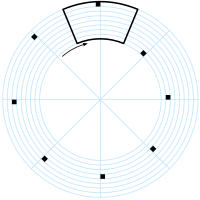Electronic television
In 1908, Alan Archibald Campbell-Swinton, fellow of the Royal Society (UK), published a letter in the scientific journal
Nature in which he described how "distant electric vision" could be achieved by using a cathode ray tube (or "Braun" tube, after its inventor, Karl Braun) as both a transmitting and receiving device,
the first iteration of the electronic television method that would dominate the field until recently. He expanded on his vision in a speech given in London in 1911 and reported in
The Times[17] and the Journal of the Röntgen Society.
In a letter to
Nature published in October 1926, Campbell-Swinton also announced the results of some "not very successful experiments" he had conducted with G. M. Minchin and J. C. M. Stanton. They had attempted to generate an electrical signal by projecting an image onto a selenium-coated metal plate that was simultaneously scanned by a cathode ray beam.These experiments were conducted before March 1914, when Minchin died,
[22] but they were later repeated by two different teams in 1937, by H. Miller and J. W. Strange from EMI,
[23] and by H. Iams and A. Rose from RCA.
[24] Both teams succeeded in transmitting "very faint" images with the original Campbell-Swinton's selenium-coated plate. Although others had experimented with using a cathode ray tube as a receiver, the concept of using one as a transmitter was novel.
[25] By the late 1920s, when electromechanical television was still being introduced, several inventors were already working separately on versions of all-electronic transmitting tubes, including Philo Farnsworth and Vladimir Zworykin in the United States, and Kálmán Tihanyi in Hungary.
On September 7, 1927, Farnsworth's Image Dissector camera tube transmitted its first image, a simple straight line, at his laboratory at 202 Green Street in San Francisco.
[26][27] By September 3, 1928, Farnsworth had developed the system sufficiently to hold a demonstration for the press.
[27] In 1929, the system was further improved by elimination of a motor generator, so that his television system now had no mechanical parts.
[28] That year, Farnsworth transmitted the first live human images with his system, including a three and a half-inch image of his wife Elma ("Pem") with her eyes closed (possibly due to the bright lighting required).
[29]
The problem of low sensitivity to light resulting in low electrical output from transmitting or "camera" tubes would be solved by Tihanyi beginning in 1924.
[35] His solution was a camera tube that accumulated and stored electrical charges ("photoelectrons") within the tube throughout each scanning cycle. The device was first described in a patent application he filed in Hungary in March 1926 for a television system he dubbed "Radioskop".
[36] After further refinements included in a 1928 patent application,
[35] Tihanyi was awarded patents for the camera tube in both France and Great Britain in 1928, and applied for patents in the United States in June of the following year. Although his breakthrough would be incorporated into the design of RCA's "iconoscope" in 1931, the U.S. patent for Tihanyi's transmitting tube would not be granted until May 1939. The patent for his receiving tube had been granted the previous October. Both patents had been purchased by RCA prior to their approval.
[37][38] The idea of charge & storage (with various and very different technological solutions) is still remained
[39] as a basic requirement for all type of modern image sensors until this day.



